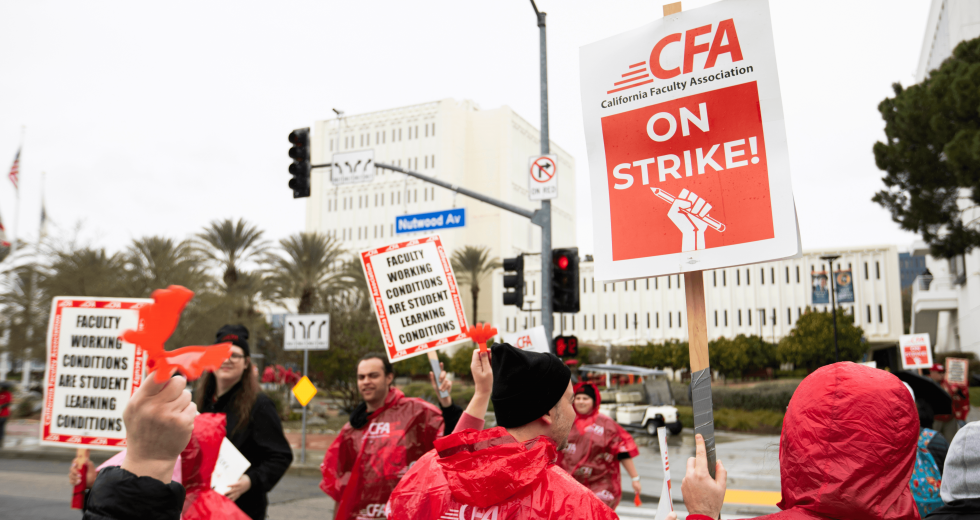An overwhelming majority of California Faculty Association members voted to authorize a strike in November 2023, and the association shut down the California State University system on January 22. The strike, initially planned for a full work week, ended after one day when union leadership declared they had reached a tentative agreement with CSU management.
Educators, along with coaches, counselors and librarians on the 23 CSU campuses, went on strike for a 12 percent raise for all faculty and to raise the salary floor for the lowest paid lecturers. Unlike in the sister University of California system wherein the tenure-line and tenured professoriate, called senate faculty, are not unionized, and lecturers off the tenure track are affiliated with the American Federation of Teachers, the CFA represents both lecturers off the tenure track as well as tenure-line and tenured faculty throughout the CSU system.
Fighting for a raise for all in the context of skyrocketing inflation in the Golden State and to significantly improve the salaries of those who, despite having earned master’s degrees and doctorates, are just scraping by, gained traction with both of the aforementioned cohorts.
“If we can kind of change that culture in our institution, then it could have a domino effect the way … the UAW strike with the UCs had a domino effect for grad students,” Guy Hepp, an associate professor in anthropology at California State University San Bernardino, says while trying to capture a sentiment that has swept his union.
Hepp says his CFA membership was inspired by the UC academic worker strikes, and he and other members of the CFA chapter at CSUSB stood on the picket lines at UC Riverside, where his wife is a doctoral candidate.
“If we can make real change in the way that administration and faculty and students articulate on campus, it could have a domino effect across the country,” Hepp explained. “And if that happens, it could have a domino effect internationally.”
Critical political economy of ‘The People’s University’
To insert a bit of relevant context as regards the upper-level university management, the current CSU chancellor, who’s set to receive some $795,000 in annual salary plus thousands in benefits, received a 27 percent salary increase when compared to what the previous chancellor pulled in.
Meanwhile, as Hepp and lead author, fellow CSUSB professor Thomas Corrigan, explained in an op-ed published earlier in January, CSU management compensation has increased 32 percent since 2016 and the university’s Board of Trustees voted in September 2023 to raise student tuition by 34 percent over the next five years.
Their campus president suggested the tuition hike would go toward salary raises for faculty and staff, but the union ended up striking after the CSU management walked away from the bargaining table in response to the proposal for faculty salary increases. For what was once regarded as “The People’s University” to “provide the transformative education our students and communities deserve,” they wrote, educators “need better pay and safe, equitable working conditions.”
Brian Dolber, a CFA member and associate professor of communication at CSU San Marcos, says that in this economy and especially in California, professors cannot live on the salaries they receive. Dolber, whose wife is faculty at CSU Fullerton, says that even in his dual-tenure household they struggle month to month. Daycare and their mortgage alone is the equivalent of about one partner’s salary in full. “That means that you cannot be a tenured professor and be a single parent who needs daycare,” Dolber says.
The tentative agreement that CFA leadership reached after, perhaps prematurely, calling a truce in a class war still aggressively and rapaciously waged from above, includes some but not all of what many in the union went on strike to win, including salary increases.
The TA includes the measure to raise the floor for those at the bottom, who if the contract gets approved would receive $3,000 on top of a general salary increase.
Dolber called that amount “completely insufficient,” and emphasized that not all lecturers are teaching full-time — five classes per semester — and thus will not reap the same compensation.
The TA that brought faculty back into Cal State classrooms also sacrifices the 12 percent raise for all faculty that many opted to strike for in favor of a 5 percent salary increase for all. With the current agreement, faculty active from July 1, 2023, until the time the contract goes into effect will receive a retroactive 5 percent general salary increase. All faculty, per the TA, will also receive a 5 percent salary increase on July 1, 2024, “so long as the ongoing base funding from the state of California does not decrease from fiscal year 2023/2024 as set out in the California Budget Act of 2023.”
Budget-based contingency is a stipulation many rank and file CFA members have opposed because it prevented the raise faculty expected to get from the last contract.
“The fact that we did not get the budget that would have triggered the raise, even as it was only 4 percent, to me showed some, I’ll say, flawed logic on the part of the leadership because you don’t agree to a contingent raise,” explained Dolber. “You know that there’s a reason that they’re putting in that contingency, and it’s because they’re going to make sure that you don’t get it — or they’re going to try very hard. … They’re leaving open that possibility for a reason.”
The strike vote CFA members took in November ought to authorize the union’s statewide board to continue to call strikes, and Dolber sees that as a “real necessity,” if the rank and file vote down the agreement. Dolber and Hepp both says vocal faculty on different CSU campuses have expressed an intent to vote no.
“We need to fight for more,” Dolber says in relation to what a no-vote on the TA would mean. “We’re willing to fight for more because we voted it down, and we understand it’s gonna be a struggle. But then, yeah, I think that we need to go back on strike if we vote no.”
Membership has yet to decide if they’ll accept the 5 percent raise offered.
Bargaining for community and the common good
They’re also weighing the adequacy of other concessions the union got from CSU management.
Prior to the strike the CFA proposed course caps to reduce ever-increasing workload. Class size limits and workload concerns affect public education from the K-12 up to the college level. Large class sizes can compel faculty to choose between maintaining a modicum of work-life balance and adequately attending to every student to provide the highest quality of education possible. Incessant work obligations exacerbated by large class sizes and thus more assignments and exams to evaluate and offer feedback on can, in addition to causing undue stress, lead faculty to neglect their mental and physical health.
What is more, workload creep poses a threat to the kindling of community, especially amid our nationally recognized loneliness epidemic. Excessive labor time further represents an additional challenge to building a strong labor movement by leaving would-be participants too exhausted or burdened with work to get involved.
A legally binding reduction in workload could be a step in the direction of de-corporatizing the university. It would insert a small wrench in the machine of the higher education business model that prioritizes efficiency over people’s wellbeing, and it could free academic workers up to organize and build community part and parcel of the public good.
The TA reached between the CFA and the CSU notes that a faculty member can raise excessive workload issues with the appropriate administrator, but it does not include class size caps, leaving that issue largely unaddressed.
In an embrace of the society-wide movement for accessible mental health care and that could benefit more than those directly covered by a contract, the CFA pushed for improved counselor-to-student staffing ratios. The proposal went beyond self-interested bargaining by recognizing the importance of prioritizing the well-being of an interconnected campus community.
The TA reached after the one-day strike features watered down, if still encouraging apropos provisions, suggesting that campuses should “endeavor” to reach the goal of one counselor per 1,000 to 1,500 students if they have not already achieved that ratio, and it notes that the parties agree to meet in 2026 to discuss counselor staffing.
In what some might see as a small-yet-desirable win for faculty well-being, the recently reached agreement affirms that instructors are not required to comply with a request to be interviewed by law enforcement. If a university employee opts to participate in an interview with an officer, the TA notes the individual “may request to be accompanied by a union representative” and, if that right is denied the person, “has no obligation to participate.”
In addition, the agreement that the CFA bargaining team negotiated calls on the university to make the location of gender-inclusive restrooms and lactation spaces known to the campus community, adding a bit of transparency to what’s already in existence and, as regards the latter, already required by law.
Parental leave as a pivotal issue
But aside from compensation, the bargaining issue CFA members might be mulling over most in deciding whether or not to endorse the TA pertains to parental leave.
Dolber got involved in the union’s most recent organizing wave, he says, after his wife had a baby in 2020. Human resources on his wife’s campus offered to combine sick leave, Family and Medical Leave Act funds and other forms of leave so she could keep most of her salary and take a whole semester off.
Dolber’s wife took the deal she was offered at CSU Fullerton, which was better than what the existing collective bargaining agreement required the university to provide.
“Well, at the end of the day, what happened was she had to have a C-section, and once that got reported, without even telling her, they put her on disability pay,” Dolber explained.
When he and his wife looked at the pay she received a few months after the baby was born, they realized about half the salary was missing.
“And so we’re like, ‘What the hell happened?’ … We had hospital bills to pay,” Dolber says. “We were scrambling to find out what happened to her money.”
According to Dolber, the university cut money from multiple paychecks his wife received thereafter.
“This is why we need a full semester (of paid parental leave),” Dolber says. “It should be no-questions-asked. Forget all of this chicanery of moving around different kinds of leave and different sorts of packages.”
Dolber, who’s now chair of the communication department at CSU San Marcos, added that it’s far easier to hire a lecturer at the beginning of a semester to teach a class the entire term than it is to hire a lecturer to come in for just part of the semester, expecting the full-time faculty person to return and be an effective instructor after having missed a good portion of the class.
Prior to the strike, the CFA proposed extending paid parental leave from 30 days to one semester, or two quarters. Article 23 in the new TA modestly increases paid parental leave from 30 to 50 days.
Hepp acknowledged the TA has improvements, even if they aren’t as much as members wanted. The father of a 7-month-old baby, he also paid a lot of attention to the parental leave issue. He noted that in addition to the new agreement increasing that leave from six to 10 weeks, the TA features related workload reduction options as well.
The previous contract permitted faculty to opt for a workload reduction of 40 percent for a semester or 60 percent for a quarter in lieu of taking a month of paid parental leave. The new TA increases the teaching unit reduction to 60 percent for a semester or 100 percent for a quarter.
While Dolber says the options don’t necessarily do much for someone like his wife who has to stay at home with a newborn, Hepp considers the improvement important.
“A bunch of people solidified their opinions about the tentative agreement before the information was really available,” Hepp explained, “and I’m afraid it’s dead in the water now.”
Transformative public education and the fate of the tentative agreement
Regardless, Hepp believes CFA chapters can benefit from building stronger connections with other unions and a stronger presence in local labor communities.
“I think we need to fight with our students side by side against things like the tuition hikes,” he added. “We need to use things like labor organizing … as a learning opportunity. Our students joined us on the line. My students knew what was going on.”
He also stressed the need to be clear about where the union stands while at the same time showing an eagerness to continue learning, remaining open to different perspectives. While he isn’t sure what will happen, he sees the rank-and-file insurgencies of sorts that have recently driven unions like the UAW and SAG-AFTRA to make big gains as sources of inspiration.
“If we’re going to get better contracts, and we’re going to have more power, we need, I think, to really push the leadership,” he added. “And if that doesn’t work, we need to replace the leadership to do what it takes to really benefit people in conditions where the jobs are drying up and the pay is completely insufficient.”
Using the strike simply as a measure to get the university to return to the bargaining table will result in continually losing ground, he says.
“The raises compile, but also the debt compiles,” he says. “If I don’t get a 12 percent raise this year, my credit card bills are going to be skyrocketing. My APRs are higher than 12 percent. I think it’s very, very short sighted to say, ‘Okay, well, we’ll fight again another time.’ We never make up the lost ground. We’re still trying to make up the lost ground for settling on a bad contract last time with a contingent raise. Fool me once, shame on you. Fool me twice, shame on me, you know?”
James Anderson is from Illinois but now resides in Riverside, California. He has taught college courses as an adjunct professor and his work has appeared in a number of outlets. He’s a member of the IWW Freelance Journalists Union. You can read more of his work at waywards.substack.com.
–
Stay up to date on business in the Capital Region: Subscribe to the Comstock’s newsletter today.
Recommended For You

California State Scientists Strike, Demand Equal Pay
CalMatters: Hundreds of scientists working for the state of California to protect water supplies, respond to oil spills, study wildlife and track foodborne outbreaks marched in Sacramento Nov. 15 in what’s being called the first-ever strike by state civil servants.

The Wage of Innocence?
Comstock’s president and publisher reflects on minimum wage and the value of work.



